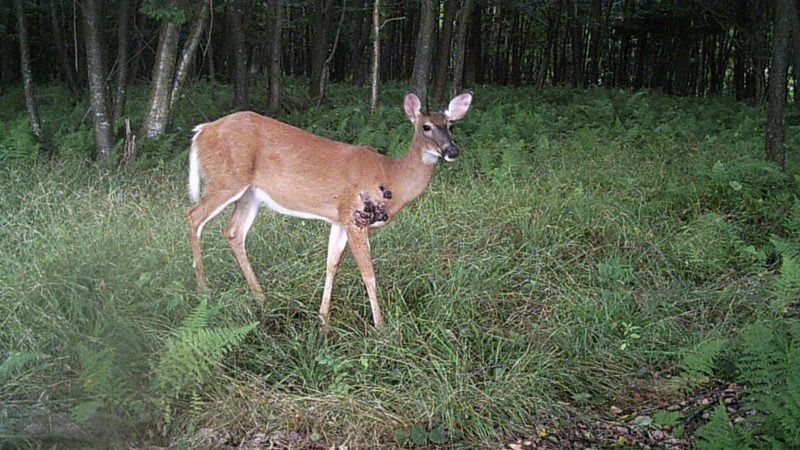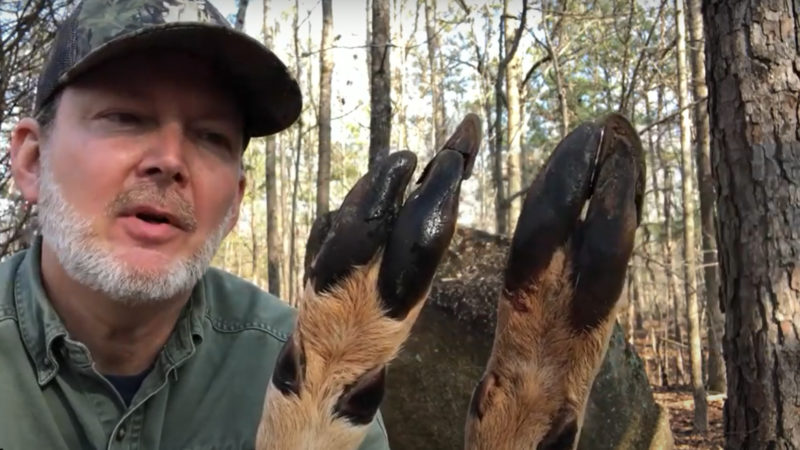Ask anyone why they hunt, and invariably, at or near the top of the list of reasons, is to put meat in the freezer. Hunting for our own food is participating in the subsistence way of life. Providing for ourselves and our families, putting food on the table. And above all, venison is among the healthiest foods you can eat. Organic and lean, venison contains none of the artificial hormones often pumped into pen-raised beef and pork.
That said, whitetail deer do occasionally contract illnesses and diseases that can make them unsafe to eat. Let’s look at a few of those and determine if the deer you harvest this fall will make great table fare and what to do if you kill one that isn’t edible.
Cutaneous Fribromas
Cutaneous Fibroma, also known as “deer warts,” can be shocking to see on a deer. These tumor-like growths can range from mild to severe, and at times can appear quite grotesque, especially when they appear in clumps around the animal’s face.
For the most part, deer warts are harmless, but seeing them on the deer you just harvested can be a turn-off when it comes to wanting to eat it. After all, so much of what we enjoy eating is tied to its appearance, and it can be difficult to mentally get past the sight of so many ugly warts covering the hide of the animal you intend to consume.
However, cutaneous fibroma are mainly a skin disease caused by infected wounds. Once the animal is skinned, the meat underneath should be just fine. In rare occasions, though, cases of cutaneous fibromas can be so severe that the tumors can effect the meat under the skin. If you harvest a deer with a severe case of warts, be sure to check the meat thoroughly before consumption.

Hemorrhagic Disease
Hemorrhagic Disease (HD) primarily refers to two separate viral diseases in whitetails: Epizootic Hemorrhagic Disease (EHD) and bluetongue (BTV). Both are transmitted by biting midges of the genus Cullicoides, and outbreaks tend to occur in warmer weather, from August to October. Deer with HD can appear just fine in the early stages of each virus. Once symptoms progress, they can develop fevers, swollen necks, tongues, and eyelids, and show excessive salivation. All of these are reasons why we often find deer that have died of HD near water. Other symptoms include emaciation and interrupted hoof growth, and infected animals will appear in overall poor health.
Once a deer has contracted HD, it can die in one to three days. Long before hunters have a chance to harvest that animal, so HD often goes unnoticed until after the fact. Although HD is typically fatal, some deer do recover. There is no risk to humans for handling and consuming meat from deer that currently have HD or have recovered from HD. However, HD can cause other secondary bacterial infections to develop, so thoroughly check all meat before butchering, if you suspect that deer has or had HD.

Chronic Wasting Disease
There’s so much we don’t know yet about Chronic Wasting Disease (CWD), but we do know that every year it is showing up in places where it has never been found before. CWD is part of a group of diseases known as transmissible spongiform encephalopathies (TSE) that cause brain degeneration in deer, elk, and moose. In later stages of the disease, infected animals appear lethargic, disoriented, emaciated, stumbling, have tremors, and excessive salivation.
CWD is 100% fatal for the infected animal, but here’s the catch: it can take months for that animal to show signs of the disease. Therefore, it’s very likely that many hunters where outbreaks have occurred in recent years have already consumed or will consume deer with CWD without even knowing it.
No worries. Eating deer with CWD is not harmful to humans, and there is no evidence that CWD can infect humans or domestic livestock. As long as the animal displays no advanced signs of CWD, you should feel confident adding it to your freezer.

Brain Abscesses and Infection
Brain abscesses and infection are similar in nature, and both are generally caused by wounds that have not healed correctly. Bucks are more prone to brain abscesses and infections simply because they fight more for breeding rights, rub trees, and generally exhibit more aggressive behaviors than their female counterparts.
Symptoms of brain abscesses and infection can be similar to the diseases already mentioned: disorientation and confusion, stumbling, circling, emaciation, and lethargy. In fact, at first glance, a whitetail with a brain abscess or severely infected wounds can display all the signs of an animal with an advanced case of CWD. However, upon harvest, a close inspection of the carcass often reveals a physical injury.
Chances are, if you’ve harvested multiple whitetails throughout your hunting career, you’ve already encountered brain abscesses and infection, especially if you’ve ever caped out a buck you wanted to have mounted. Abscesses typically appear around the antlers or on the face of whitetails. If they don’t heal correctly, deeper infections can develop and spread throughout the deer’s system. There’s actually been quite a bit of research in the southeastern US regarding mortality rates of bucks due to brain abscesses. Researchers estimate that approximately 10% of buck mortality is a result of these wounds.
Infections can develop in other ways, too, such as vehicle-deer collisions where the impact may not kill the deer outright but can cause wounds severe enough that the animal succumbs later to the resulting infection. The same is true of deer that suffer injuries during hunting season from a poorly-placed shot. It may not be fatal at the time, but if severe infection sets in, the deer will eventually expire.
If you shoot a deer with any type of abscess on its body, check the area around the abscess thoroughly. Although the meat in the immediate vicinity of the wound may have to be discarded, the rest will be edible. In extreme cases, though, infection can spread throughout all of the meat. If you suspect that is the case, don’t take any chances and throw it out.
What to Do
If you harvest an animal that you suspect has an illness such as CWD and HD, or shows advanced signs of infection or deer warts, call your local conservation officer or game warden as soon as possible. Even if you’ve already tagged the animal and don’t discover the problem until you’re at home processing the meat, make the call. These incidents are not uncommon, and in most cases, the conservation officer or game warden will issue you a new tag so that you can hunt for another deer.
Although diseases in whitetails are and should be a concern for hunters, rarely do they present health problems when it comes to eating those animals. When processing the meat, always inspect it thoroughly, and it’s absolutely okay to err on the side of caution. If the deer you harvested displays questionable symptoms or you suspect it may have been infected with disease, always call your local conservation officer or game warden to make sure the animal is safe to eat.

 By
By 



